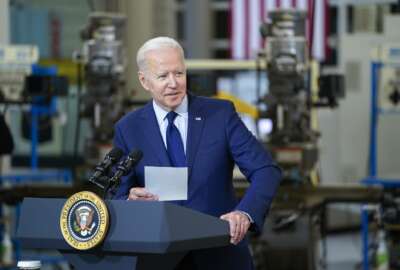
Pentagon’s $842B budget boosts procurement, R&D as personnel levels shrink
Even accounting for inflation, DoD's 2024 budget is the largest it's proposed since the peak of the wars in Iraq and Afghanistan. Weapons procurement and R&D are...
The Pentagon on Monday rolled out the details behind what would be its largest budget since the height of the wars in Iraq and Afghanistan, emphasizing what officials said was the need to make new investments to prepare for a potential conflict with China, the country officials routinely refer to as DoD’s “pacing threat.”
The proposed spending package for fiscal 2024 totals $842 billion, $26 billion more than what Congress appropriated for 2023. Defense officials said that figure would represent real growth of 0.8% once the Office of Management and Budget’s assumptions about inflation in 2024 are taken into account.
Like the rest of the federal workforce, DoD employees and military personnel would see pay increases of 5.2%, the largest military pay raise in 20 years, and the largest in 40 years for the civilian workforce. Military members would also get increases of 4.2% and 3.2%, respectively, in their housing and subsistence allowances. Those compensation increases are at least part of the explanation for why DoD’s spending on military personnel is set to increase by $6.7 billion in 2024, even though it would have 11,500 fewer service members than Congress authorized this year.
In at least three specific areas — procurement, R&D and space — Defense officials said the budget was the largest the department had ever proposed.
“First and foremost, this budget is a procurement budget. It puts its thumb on the scale in favor of game-changing capabilities that will deliver not just in the out years, but in the near term, too,” Deputy Defense Secretary Kathleen Hicks told reporters Monday. “These investments include a mix of munitions, platforms, communications, data links and cyber tools, among other capabilities, married with novel operational concepts for how to employ them. Together, they not only strengthen how we project power across long distances and hold key targets at risk, including in highly-contested environments, they also afford us the ability to disrupt potential adversaries at the military systems level, ensuring that in conflict, adversary forces will be less than the sum of their parts.”
Overall, the budget proposes to spend $170 billion in DoD’s procurement accounts, a nearly $6 billion increase from 2023 levels.
R&D would also see a boost: nearly $145 billion in total spending, up from $140 billion this year. The department said some of its main priorities within those accounts would be advanced technology ($9.3 billion), basic research ($2.5 billion), artificial intelligence ($1.8 billion) and Joint All-Domain Command and Control ($1.4 billion).
The department’s spending on military personnel would also rise in 2024 — from $172 billion to $179 billion — even as each of the military services expects their end strength to be smaller than what Congress authorized in 2023. Officials said the flat-to-slightly-shrinking numbers of military personnel were largely due to recruiting challenges posed by a tight private sector labor market.
The Army — by far the largest service in terms of personnel — believes it can maintain an active duty force of 452,000 in 2024, the same number Congress authorized for this year. But that figure is down from a force of nearly 466,000 in 2022.
“Certainly we did not choose to reduce the size of the Army in the 2024 submission,” said Maj. Gen. Mark Bennett, the Army’s budget director. “This reflects our desire to build our end strength over the [five-year budget plan], but there are significant uncertainties regarding the recruiting market. It did not take one year to get into this situation, it will take several years to get us out of it. We are not alone across the department and facing a historic recruiting challenge. And we are pulling a significant number of levers and undertaking a significant number of reforms, all of which are resourced in the FY 24 budget to help us improve our recruiting performance.”
Each of the other military services expect that their end strength for both 2023 and 2024 will be lower than what Congress authorized this year. The Navy projects it will end this year with 342,000 active duty sailors, about 12,000 fewer than its authorized level. The Marines expect an active end strength of 172,000, 5,000 below their authorization. The Air Force projects 322,000 active airmen, about 3,500 fewer than Congress authorized.
“Recruiting at any time in my lifetime would have been tough at this kind of unemployment level, where people have so many other opportunities, especially the people that we want,” said Mike McCord, DoD’s comptroller and chief financial officer. “We want talented people, people with drive, people with high school degrees, people with technical skills. That’s going to be a challenge, and the services recognize that.”
On the information technology front, DoD says it plans to spend $13.5 billion on cyber in 2024. Among the priorities are “operationalizing” the department’s new zero trust cybersecurity framework, increasing U.S. Cyber Command’s number of cyber mission teams from 142 to 147, and finally getting DoD’s industry-focused Cybersecurity Maturity Model Certification (CMMC) program up and running.
McCord said the department also plans to put significant funding toward eliminating technical debt throughout the military services and Defense agencies.
“For those of you who remember the thread that was going around on Twitter — ‘fix our computers’ — that really resonated,” McCord said. I don’t think we had more support at any particular meeting than on investing in that. So that, plus investing in enhancing our cloud computing efforts – I’m really glad that we are beyond all of the years of protest on that, and we’re going to move forward on both those fronts. Those are examples of some of the ways we’re trying to get better inside our house here.”
DoD officials said space-based capabilities are another major focus area in the 2024 budget, and that the $33 billion the department is proposing for space systems is the largest amount ever. Some of the biggest expenses would be $5 billion for new missile warning technologies, $4.7 billion for satellite communications improvements, and $1.3 billion for maintenance and improvements to the GPS constellation.
And the Space Force, DoD’s newest and smallest service, would get a 13% budget increase — to $30 billion — as that service continues to grow.
“Winning takes space-enabled multi domain operations and a joint force trained on current operational concepts,” said Kristyn Jones, who is currently performing the duties of the undersecretary of the Air Force. “We must shift to a resilient and effective space order of battle and ensure we have the tools, talent and experience to enable space superiority.”
Copyright © 2025 Federal News Network. All rights reserved. This website is not intended for users located within the European Economic Area.
Jared Serbu is deputy editor of Federal News Network and reports on the Defense Department’s contracting, legislative, workforce and IT issues.
Follow @jserbuWFED





